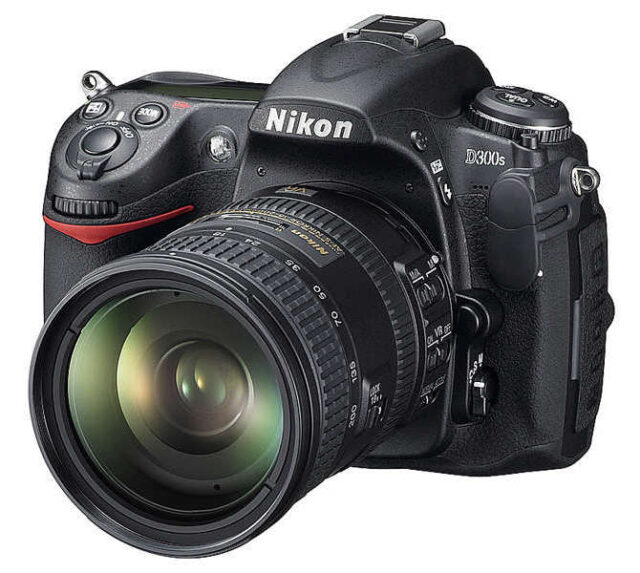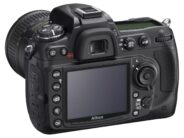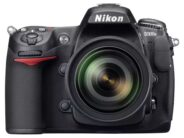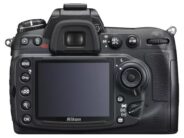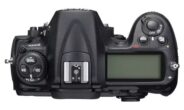Announced
Production status
System
Nikon F APS-C system cameras
- Nikon D1
- Nikon D100
- Nikon D1H
- Nikon D1X
- Nikon D200
- Nikon D2H
- Nikon D2Hs
- Nikon D2X
- Nikon D2Xs
- Nikon D300
- Nikon D3000
- Nikon D300s
- Nikon D3100
- Nikon D3200
- Nikon D3300
- Nikon D3400
- Nikon D3500
- Nikon D40
- Nikon D40X
- Nikon D50
- Nikon D500
- Nikon D5000
- Nikon D5100
- Nikon D5200
- Nikon D5300
- Nikon D5500
- Nikon D5600
- Nikon D60
- Nikon D70
- Nikon D7000
- Nikon D70s
- Nikon D7100
- Nikon D7200
- Nikon D7500
- Nikon D80
- Nikon D90
Nikon D300s
APS-C AF digital SLR camera • Discontinued
Specification
| Format: | |
| APS-C | |
Imaging sensor: | 23.6 × 15.8mm CMOS sensor |
Resolution: | 4288 × 2848 - 12 MP |
Crop factor: | 1.52x |
Sensor-shift image stabilization: | - |
| Nikon F [46.5mm] | |
| Shutter: | |
Type: | Focal-plane |
Model: | Electronically controlled |
Speeds: | 30 - 1/8000 + B |
| Exposure: | |
Exposure metering: | Through-the-lens (TTL), open-aperture |
Exposure modes: | Programmed Auto |
| Aperture-priority Auto | |
| Shutter-priority Auto | |
| Manual | |
| Physical characteristics: | |
Weight: | 840g |
Dimensions: | 147x114x74mm |
Manufacturer description
Amsterdam, the Netherlands, 30th July 2009 – Nikon announces the D300S, a camera to broaden the possibilities for today’s creative image makers.
The D300S brings HD movie capability, a faster frame advance rate of 7fps and dual CF and SD memory card slots to offer new opportunities to explore creative imaging. Built upon the widely acclaimed D300, the D300S incorporates the same DX-format 12.3 megapixel CMOS sensor, professional 51-point autofocus system and commended EXPEED image processing in a discrete compact body.
Robert Cristina, Manager, Professional Products for Nikon Europe, comments: “The D300S is designed for today’s generation of creative image makers who want to combine brilliant stills in photography with the creative potential of video capture. The DX format has the advantage of lens magnification, compact size and affordability making the D300S a really exciting package for anyone looking to take their photography to another level”.
Capture and Edit HD Movies in stereo
The D300S comprehensively extends DSLR HD movie capture by adding external stereo sound input, autofocus capability and premieres in-camera movie editing. External stereo microphone support adds more realistic sound to shooting movie clips, and a new dedicated LV button makes switching between stills and movies easier than ever. In-camera movie clips can be edited by simply selecting the start and stop points during playback. Also, the new Type C HDMI interface enables editing to be carried out on an HD display if desired.
Dual slot storage media
For the first time in this class, the D300S offers the choice of dual storage media standards; CF (Compact Flash™) and SD (Secure Digital™) with options to manage how the camera records data to them. For example, one can elect to store stills to one format and movie clips to another.
Faster shooting, outstanding quality.
The D300S captures images up to a blistering 7 frames per second without requiring any additional battery pack. The optional MB-D10 pack makes 8fps possible as well as improved vertical shooting ergonomics.
The camera inherits the groundbreaking imaging technologies from the D300 such as Scene Recognition System with 1005 pixel RGB colour metering, and class-leading autofocus performance from the 51-Point Multi-CAM3500 autofocus system, which together deliver accurate autofocus, auto exposure and auto white balance control. The EXPEED image processing system delivers Nikon’s acclaimed image quality criteria of rich accurate colours, smooth skin gradations, exceptional detail with the minimum of noise, with all of the flexibility of Nikon’s exclusive Picture Control system to manage the ‘look and feel’ of your work.
Intuitive ergonomics
Significant improvements have been made to Nikon’s renowned ergonomics with the adoption of the same multi-selector to that used on the D3 series and D700 that features a centre button to trigger movie start and stop. The D300S also features a Quiet release mode for discrete photography by allowing the user to manage the mirror return manually. The dedicated Info button simplifies displays and short cuts to commonly used settings, and the built-in pop-up flash diffuser covers 16mm wide-angle field of view.
Practical performance
The 3 inch 920K dot high definition TFT monitor offers excellent image playback and movie composition support. One can also display the Virtual Horizon level during movie shooting if desired. A variety of in-camera processing tools now includes an image resize function to process RAW files to one of four pre-set dimensions to enable to do more in camera, and less on the PC.
More than just an ‘s’
The D300S comprehensive feature set is designed for anyone who is serious about the future of their photography. It proposes much more than the simple ‘s’ suffix might suggest to cement a unique position in Nikon’s comprehensive DSLR range with a practical blend of creative options, professional technologies, compact size and affordability.
The D300S will be available in two kit configurations: AF-S DX NIKKOR 16-85mm f/3.5-4.5 VR and the AF-S DX NIKKOR 18-200mm f/3.5-5.6G ED VR II.
Features
High-speed performance
One major advancement of the D300S is its ability to shoot as fast as 7 frames per second,*1 with Rechargeable Li-ion Battery EN-EL3e, and up to 8 frames per second*2 when using the optional Multi-Power Battery Pack MB-D10 and Rechargeable Li-ion Battery EN-EL4a. It also offers a rapid startup time of approx. 130 milliseconds and an amazingly short shutter release time lag of only 49 milliseconds*1.
Refined D-Movie
The D300S’s advanced D-Movie function benefits from a number of functional and technological advancements, including an external stereo microphone input enabling high-fidelity audio, plus in-camera movie editing. In Tripod mode, the D300S features contrast-detect AF.
Experimenting with Nikon’s selection of finest-quality NIKKOR interchangeable lenses — from ultra-wide-angle and fisheye to super-telephoto – will enhance the dramatic impact of HD video. What’s more, the camera’s versatile Picture Control adjustment options let you modify the tone and colour of HD video clips with remarkable ease.
AF system with high-density 51-point AF
The D300S’s Multi-CAM 3500DX AF sensor module provides an exceptionally wide area of AF coverage. With 51 AF points densely positioned across the frame, it’s designed to capture your subject accurately, even when its movement is unpredictable. Moreover, it utilises 15 powerful cross-type sensors in the centre of the frame to give you the ultimate in detection performance with any AF NIKKOR lens of f/5.6 or faster. You can also choose to shoot with 11 focus points.
The 51 AF points are employed in various focus area modes, according to subject conditions. Single-point AF mode allows you to choose a single AF point from among the 51, and in dynamic-area AF mode, you can select from 9, 21 or 51 AF points. The 51-point option offers 3D-tracking mode, which automatically shifts the focus point to match the subject's movements. Auto-area AF mode specialises in focusing on people, automatically detecting and prioritising skin tones with all 51 points.
Large, bright viewfinder with approximately 100% frame coverage
The D300S’s viewfinder features an eye-level pentaprism with approx. 100% frame coverage and approx. 0.94x magnification. The large, bright viewfinder makes for easier, more accurate composition.
DX-format CMOS image sensor; 12.3 effective megapixels
The D300S employs Nikon’s renowned DX-format CMOS image sensor that provides 12.3 effective megapixels. It delivers extraordinary image quality throughout a wide ISO sensitivity range of ISO 200 to ISO 3200 with low noise. In addition, Lo 1 for ISO 100 equivalent and Hi 1 for ISO 6400 equivalent are also available. Initial image capture data can be quickly and accurately transferred using 14-bit integrated A/D conversion. All successive internal processing is then handled at a full 16 bits. The resulting output reveals breathtaking details and remarkably smooth tonal gradations.
EXPEED image processing
Nikon's comprehensive EXPEED image processing utilises an accumulation of sophisticated Nikon technologies to ensure impeccable quality for both still images and movies, while also achieving high-speed processing and low power consumption. It also effectively reduces lateral chromatic aberration.
Scene Recognition System makes the most of the 1,005-pixel RGB sensor
Nikon's intelligent and exclusive light metering sensor applications have been refined to deliver the Scene Recognition System, which uses precise colour and brightness information from the 1,005-pixel RGB sensor to push accuracy levels for autofocus, auto exposure, i-TTL flash control and auto white balance to an unprecedented level. And in playback mode, the added Face Detection System lets you instantly zoom in on a human face in the high-resolution, 920k-dot LCD monitor.
Dual card slots for CF/SD memory cards
New for the D300, the D300S provides dual card slots, enabling the simultaneous use of both CompactFlash*3 and SD memory cards and allows photographers to select the primary recording slot. The secondary slot can record in three methods : “Overflow” recording lets you use the memory capacity of the secondary card when the primary card is full, automatically; “Backup” recording stores the same images on both cards; and “RAW primary, JPEG secondary” recording lets you record RAW data and JPEG data separately to each card. You can also copy images between the two memory cards. And when shooting D-Movie clips, it allows you to select the slot containing the card with the most available capacity.
Engineered durability
Tested on fully assembled cameras, the shutter mechanism assembly has been proven for 150,000 cycles under demanding conditions. The ruggedly constructed D300S employs a strong yet lightweight magnesium alloy for its exterior cover, chassis and mirror box, as well as for the cover of the optional Multi-Power Battery Pack MB-D10. The camera also offers comprehensive countermeasures at key points to combat invasive moisture and dust.
Easy-to-access Live View mode
Live View function, activated by pressing the dedicated Live View button, makes it easy to shoot while composing on the LCD monitor.
In Handheld mode, which allows you to recompose the frame prior to actual shooting, TTL phase-detection AF using 51 AF points is activated. Tripod mode is designed for precise focus accuracy with still subjects. It allows contrast-detect AF on a desired point within a frame.
Quiet Shutter-release mode for non-intrusive shooting
By selecting “Q” on the release mode dial, photographers can opt to substantially reduce the sound of the camera’s mirror-down during shooting. This is particularly useful when shooting in restrictive conditions such as when photographing wildlife.
Active D-Lighting for smooth tone reproduction in high-contrast lighting
By localising tone control, Active D-Lighting accurately restores the details in shadows and highlighted areas which are often lost in high-contrast lighting situations. Simply choose the appropriate setting — auto, extra high, high, normal, low or off — prior to shooting. For further options that will help you achieve your desired tone, the D300S also allows you to bracket your pictures with varying strength levels, for up to five frames, perfect for difficult lighting situations or if you don’t have the time or experience to select just one Active D-Lighting setting.
Picture Control: Customise the visual style of your images
Nikon’s Picture Control enables you to create the pictures you envisage, quickly and easily, by making specific selections and adjustments to image sharpening, contrast, brightness, saturation and hue. And with other Picture Control-compatible cameras, as long as the settings are the same, you’re able to obtain the same picture tone. The D300S offers four preset Picture Control options — Standard, Neutral, Vivid and Monochrome. You can also download two additional presets, Portrait and Landscape, from the Nikon website.
Built-in flash with 16mm lens coverage
With a guide number of approx. 17/56 (m/ft., ISO 200, 20°C/68°F) and 16mm lens coverage — wider than the 18mm of the D300 — the high-performance built-in flash supports Nikon’s original i-TTL flash control that evaluates flash exposure with greater precision for exceptional results. Compatible with the Nikon Creative Lighting System, the built-in flash controls up to two groups of remote units as a master/commander in Advanced Wireless Lighting.
Multi-Power Battery Pack MB-D10 (optional)
The optional Multi-Power Battery Pack MB-D10 supports three types of batteries: R6/AA-size batteries, along with Nikon's Rechargeable Li-ion Battery EN-EL3e and Rechargeable Li-ion Battery EN-EL4a. It combines added stability with extended shooting of up to approx. 2,950 shots*1 per charge and enables faster high-speed continuous shooting at up to 8 fps*2.
Additional Nikon D300S Features
- Virtual Horizon that is available in Live View shooting.
- 3-in., 920-k dot high-resolution LCD monitor.
- Highly efficient energy-saving design allows as many as 950 images on a single charge of the Rechargeable Li-ion Battery EN-EL3e. (CIPA Standards)
- Nikon’s Integrated Dust Reduction System including Image Sensor Cleaning function that provides effective dust reduction.
- Versatile in-camera Retouch Menus let you enhance your images without using a computer.
- Compatible with HDMI (High-Definition Multimedia Interface) output. Type C connector (mini size) is employed.
- With the optional GPS Unit GP-1, location information such as latitude, longitude, altitude and time are automatically recorded to each image’s Exif data.
- Exclusive Nikon Software — Nikon Transfer and ViewNX software packages (supplied) for a range of basic photo browsing and editing operations; Capture NX 2, Camera Control Pro 2, and Image Authentication Software (all optional) enable more advanced operation and image editing.
Similar cameras (4)
APS-C • Auto focus • Digital • Singe-lens reflex • Nikon F mount
| Model | Shutter | Metering | Modes | Year |
|---|---|---|---|---|
| Fujifilm FinePix S1 Pro | E, 1/2000 | TTL • OA | PASM | 2000 ● |
| Fujifilm FinePix S2 Pro | E, 1/4000 | TTL • OA | PASM | 2002 ● |
| Fujifilm FinePix S3 Pro | E, 1/4000 | TTL • OA | PASM | 2004 ● |
| Fujifilm FinePix S5 Pro | E, 1/8000 | TTL • OA | PASM | 2006 ● |
